We didn’t know much about absinthe. We had heard that the drink was highly alcoholic. Also that it was banned for a long time. And we knew the rumour that Vincent van Gogh cut off his ear because he had gone mad from absinthe. When we heard that there was a multi-day walking route called Route d’Absinthe, we were eager to walk it. Also to unravel all the mysteries surrounding this special drink. It turned out to be a fantastic journey. We walked through beautiful landscapes, visited special museums and, of course, various distilleries. The Route d’Absinthe thus became a beautiful walking route that unites nature and a special history of the Jura.
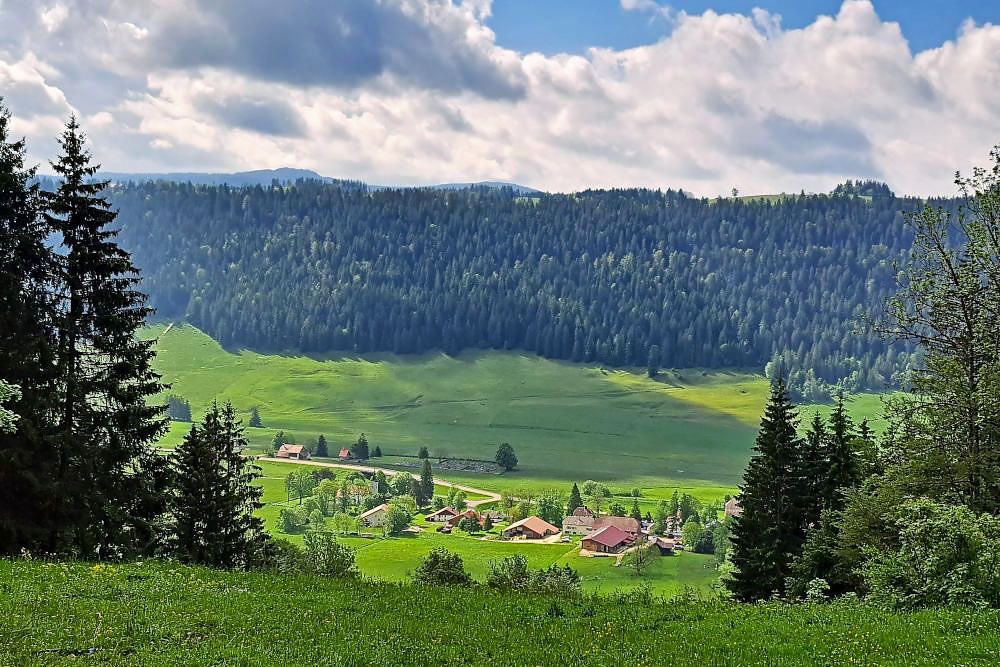
Route d’Absinthe is cross-border
This multi-day walk is cross-border in several respects. The route runs from France to Switzerland or vice versa. You don’t notice that you’re crossing the border, by the way. No border controls or customs posts. Unnoticed, you walk from one country into the other.
In another respect, too, the multi-day walk is cross-border for us. Various distilleries treat us to the anise-like drink well before noon. At home, our limit is 5 o’clock: “five on the clock, then it’s cocktail time”. This doesn’t apply on this tour. So we taste various types of absinthe on our almost empty stomachs. Fortunately, they are always small glasses, but still. The alcohol percentage is considerably higher than in wine or beer. It does ensure that we always start a new walking day in an extremely cheerful mood.
The Route d’Absinthe is 48 kilometres long in total. We start our journey in the French town of Pontarlier. It’s a marked route, with clear signs along the way. The official finish line is in the Swiss town of Noiraigue. Walking in reverse is not a problem, by the way, as the marking works both ways. The walk leads us through rolling landscapes with beautiful vistas, lovely villages and vast forests. For us, the journey ends a bit earlier. We walk in three days from Pontarlier to Couvet. That’s about 10 kilometres before Noraige.
|
Read more background information about absinthe, its popularity, prohibition and the absinthe ritual in our blog: |
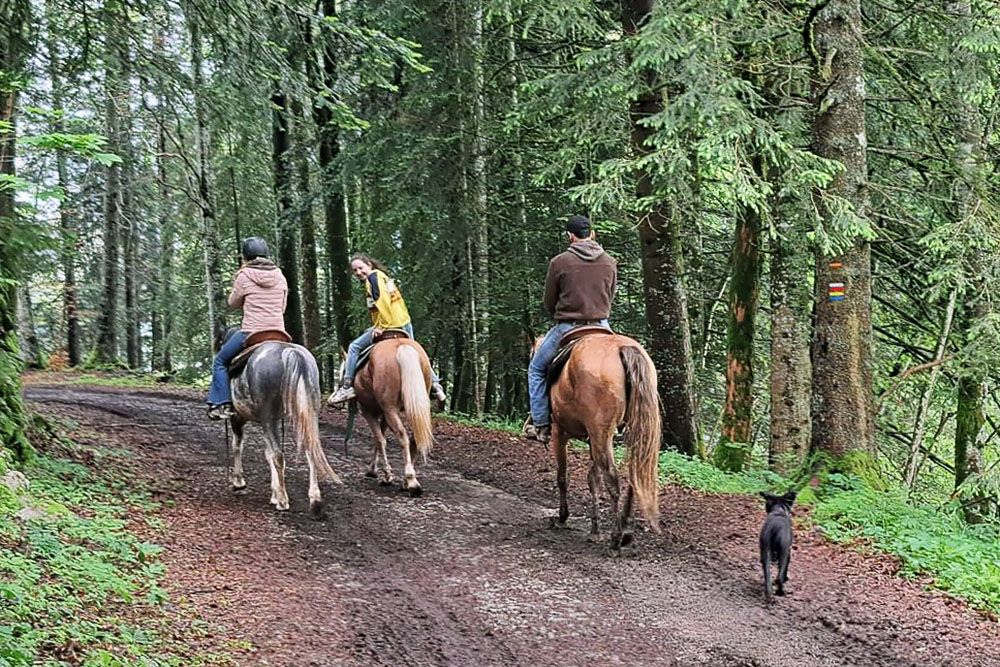
The nature during the Route d’Absinthe
Besides all the distilleries and museums, we of course also enjoy nature. We walk most of the route through Val de Travers in Switzerland. A hilly landscape with spruce forests, the hills of the Jura and steep limestone formations. The undulating course provides the most beautiful views. The famous philosopher Rousseau lived in Motiers for a number of years. During the Route d’Absinthe, we cross the Via Rousseau, which is a long-distance walking route that pays homage to this philosopher.
Especially during our second stage of the Route d’Absinthe, it’s a real treat. We pass small villages, walk along farm roads with regular stunning views of the wider surroundings. The walk is not difficult, the differences in altitude are limited and the paths or roads are good. That’s why we can fully enjoy the magnificent landscape of the Jura.
Thus, the Route d’Absinthe brings together an important part of local cultural history with a walk through the French and Swiss Jura. Even if you’re less interested in the history of absinthe, the beautiful landscapes along the way ensure that you make a lovely multi-day walk where your eyes are not enough.
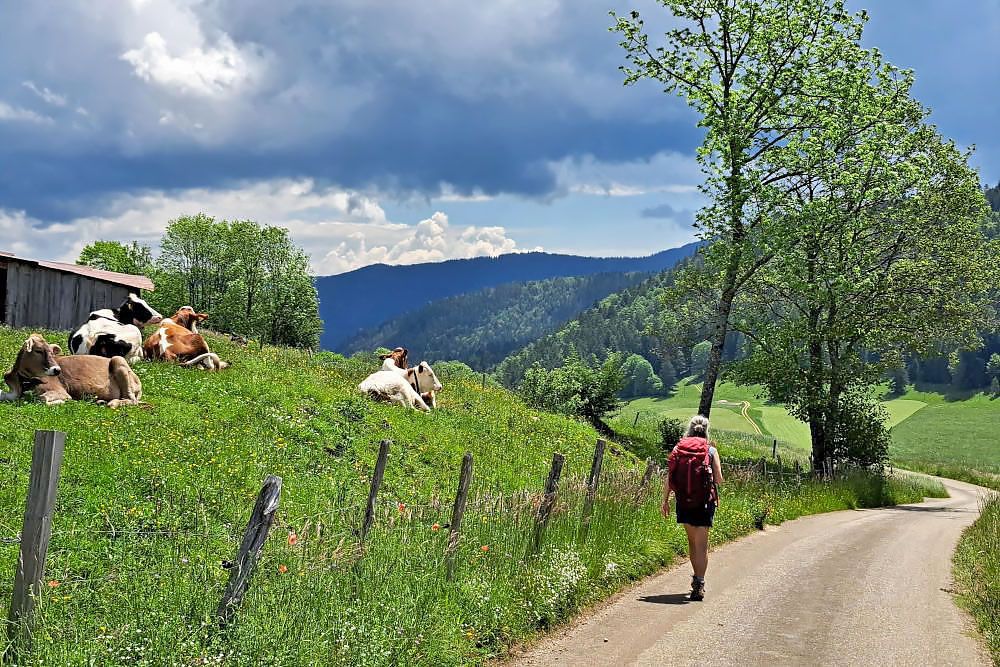
Our highlights during the Route d’Absinthe
Our walking adventure through the French and Swiss Jura is a series of special moments.
Pontarlier
First, we visit the small but interesting municipal museum in Pontarlier. This museum offers a fascinating collection that tells the history and culture of Pontarlier and the absinthe industry. We see antique absinthe bottles, beautiful old posters, and original distilling equipment. The museum gives a good picture of how absinthe was produced here in the 19th century and what it meant for the local community. Especially impressive are the artistic advertising posters promoting absinthe. In addition, the museum also has a collection of artworks and objects that illuminate daily life in the region through the centuries.
The town is very charming, with a beautiful gate and various other monuments, atmospheric shopping streets and nice restaurants. Pontarlier has been a strategic place through the centuries. There was already a settlement in the Gallo-Roman period. The town’s great heyday came many centuries later due to the popularity of absinthe. At one point, Pontarlier had many distilleries and dozens of cafés where the drink was sold.
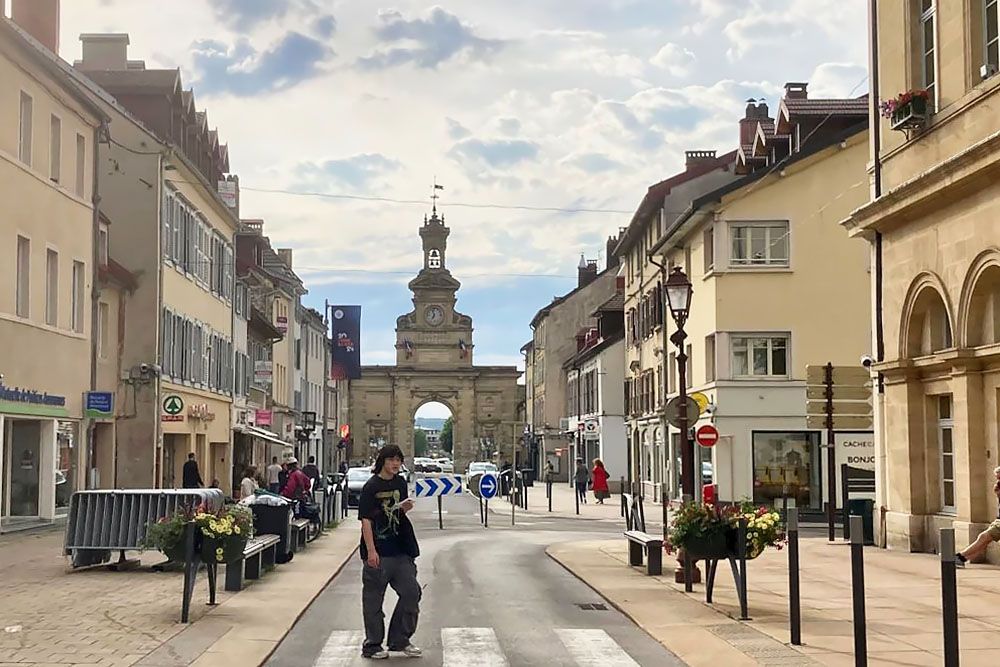
Distillerie Les Fils d’Émile Pernot
We stayed overnight in the comfortable hotel Auberge du Château de Joux. After a hearty breakfast, we start our first real walking day. Because we’re not sure if we’ll come across eateries along the way, we’re given an extensive packed lunch. The first stop presents itself soon. Distillerie Les Fils d’Émile Pernot is one of the oldest absinthe distilleries in the region. Founded in 1889, this distillery has a rich history in absinthe production. They are known for their traditional production methods and their authentic absinthe varieties, such as the “Vieux Pontarlier”. We admire the old copper distilling kettles and get an explanation of the distillation process that has been followed for more than a century. After the tour, we’re allowed to taste. Not quite on an empty stomach, but early. Cheers!
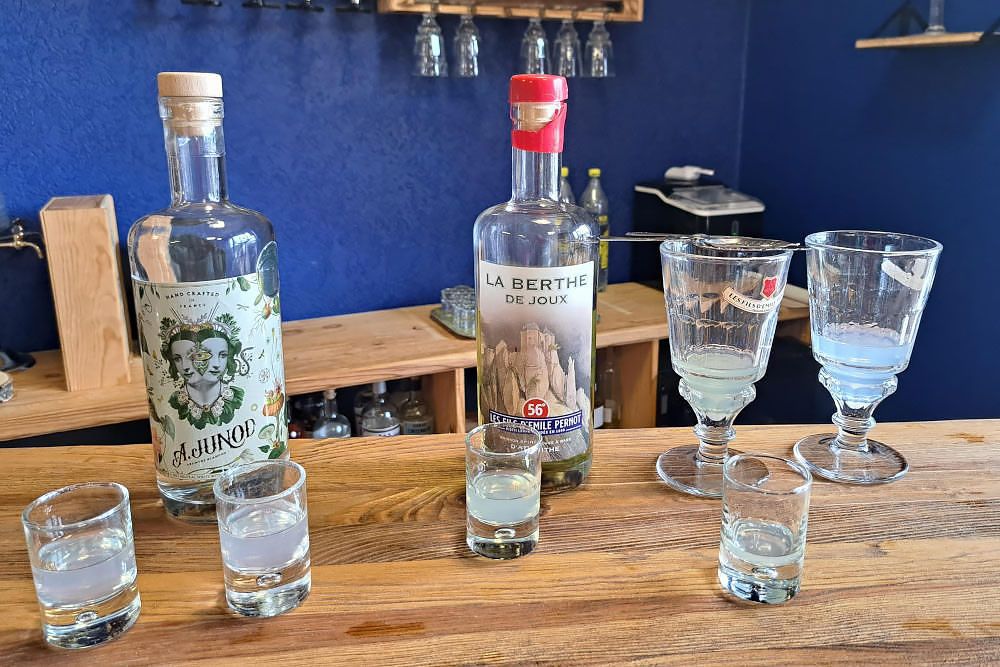
Castle of Cluse and Mijoux
Not far from La Cluse-et-Mijoux lies the imposing Château de Joux. This medieval castle has a long and rich history. Originally built in the 11th century, the castle has been expanded and fortified over the centuries. It played an important role in the defence of trade routes between France and Switzerland. We don’t visit the castle, as it’s not directly on the route. However, we have a beautiful view of the castle from Fort Mahler.
The landscape during the first day is beautiful. We enjoy the panoramic views, green meadow landscapes with grazing cows and winding paths through mainly coniferous forests. Almost unnoticed, we pass the border with Switzerland. It’s only because we spot a small border post, otherwise we would have completely missed this moment. From now on, we’re walking in the Val de Travers.
In a small hamlet, we find our hotel Les Cernets. It seems deserted and our suspicion is correct. Fortunately, there’s a note for us on the door. On it, we find instructions on how to find the key to our room and how we can get some snacks. On our balcony, we enjoy the Swiss chocolate and a cup of tea, lovely in the sunshine. A little later, the couple shows up. They’ll make sure we get a delicious dinner later that evening. The next morning, the breakfast buffet is also richly extensive. Armed with a well-filled lunchbox, we set off refreshed for the second day.
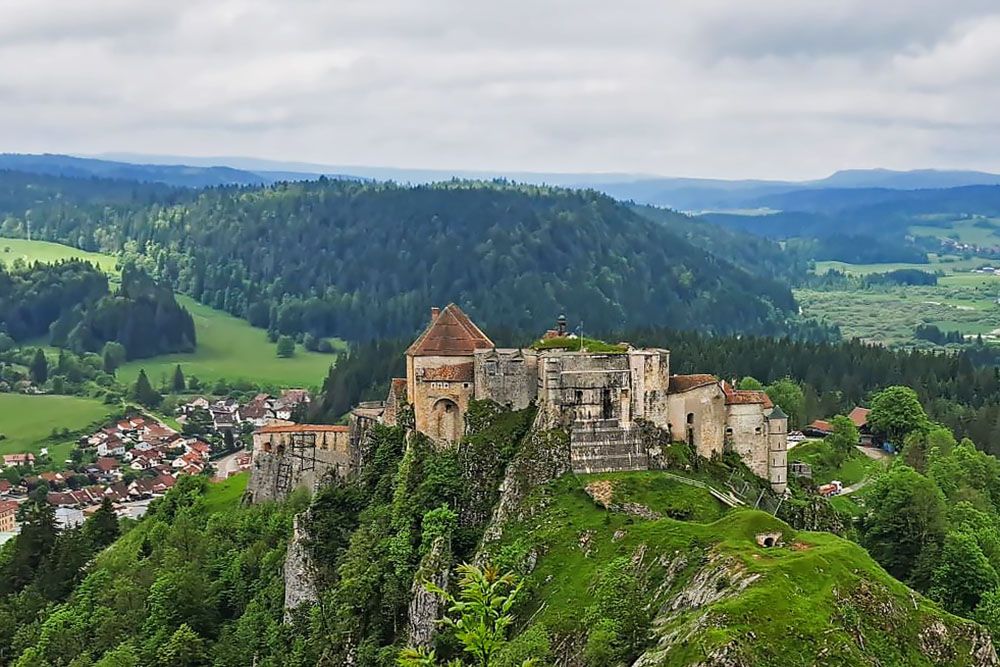
Fleurier and Celle a Guilloud
The second day is a great walking day. Every moment the view is beautiful. Eventually, we reach Fleurier, a cosy place with a nice atmosphere. Switzerland is known for its excellent watches. In the Val de Travers region, and especially the town of Fleurier, many watchmakers started their business. In addition, the cradle of two future Nobel Prize winners was in this small town.
In Fleurier, we visit Celle a Guilloud. This distillery is not large. The owner produces a limited number of types of absinthe as a hobby. He tells the special story of the first owner. At the time when absinthe was banned, he illegally produced absinthe. In the early period, he used his bath for this. Later, he switched to simple kettles. Opposite him lived the local village policeman. He probably bribed him with a few bottles, because he was never arrested.
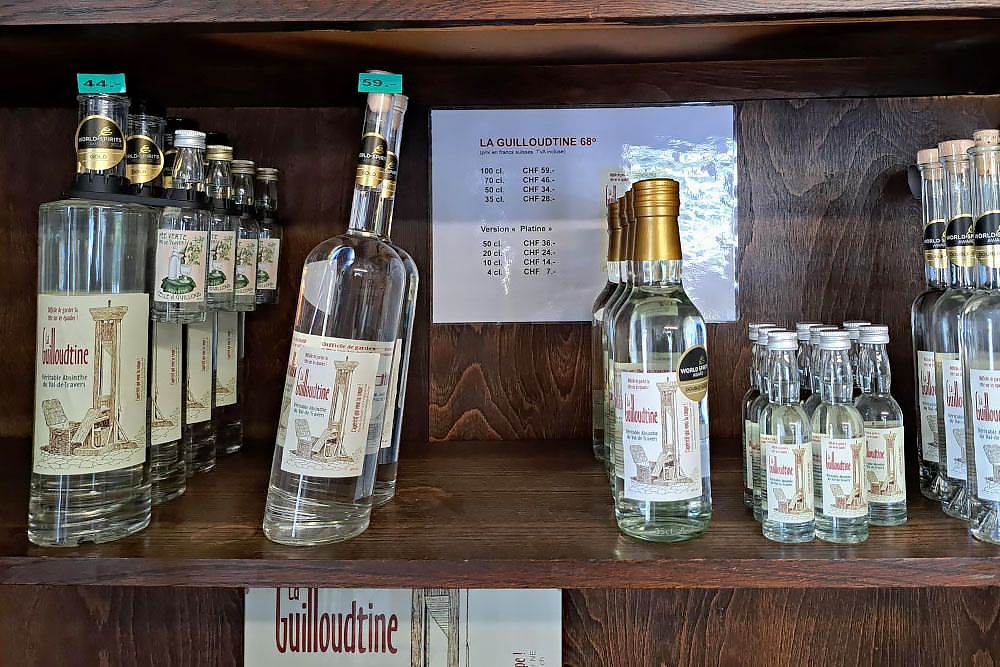
Maison d’Absinthe
In Fleurier, we stay at the pleasant B&B T22. It’s a beautiful building with an enormous garden, where we enjoy the sun splendidly. After an extensive breakfast, we leave this fantastic accommodation and friendly host. We walk towards Môtiers. On the way, we pass the castle of Môtiers. It’s private property and therefore not open to the public. We can only catch a glimpse of the structure.
Maison d’Absinthe in Môtiers is for us the highlight of the three-day Route d’Absinthe. It’s a place that absinthe enthusiasts simply must not skip on the Route d’Absinthe. This museum, opened in 2021, offers an extensive look at the history, production, and culture of absinthe.
The Maison d’Absinthe has an impressive collection of old absinthe bottles, historical distilling equipment, and authentic advertising posters. During our tour, we gain an in-depth insight into how absinthe was produced and consumed in the 19th and early 20th centuries. The number of interactive elements in the museum is also enjoyable. Maison d’Absinthe takes us through all facets of absinthe production. Of course, we conclude our visit with a tasting, delightful!
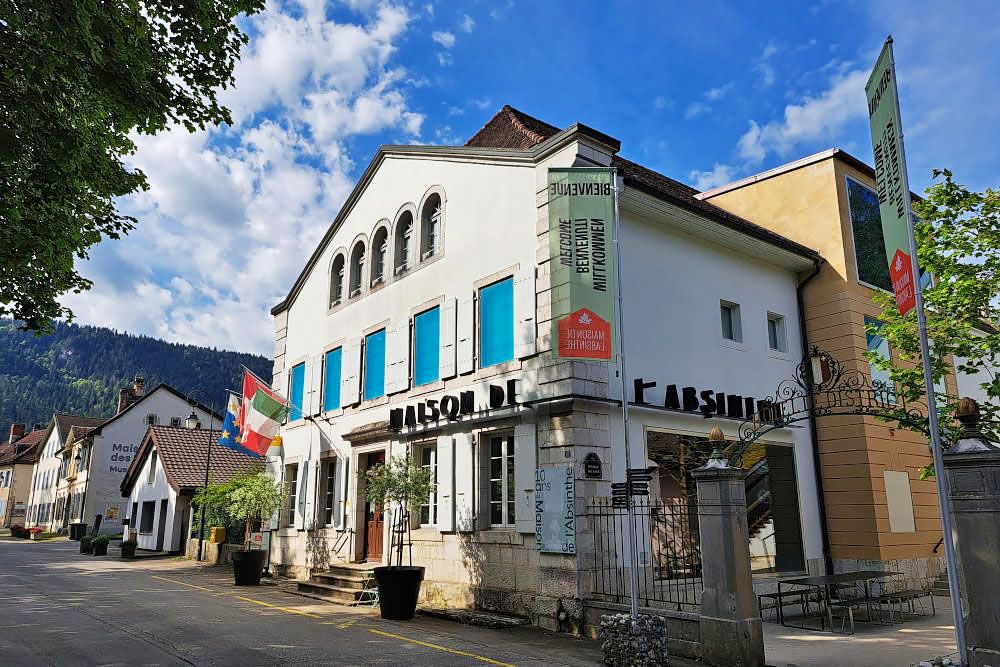
Fontaine à Louis
Our guide takes us into the forest near Môtiers. We’re going to experience a special absinthe ritual at the Fontaine à Louis. Water flows from a spring near a large tree. We’re going to use this as the absinthe fountain. Our guide fills the cups with absinthe, places the spoon with sugar on top, and lets the water drip from the fountain over the drink.
This is how we experienced how the inhabitants enjoyed the drink during the long prohibition of absinthe. They often hid their bottles in hollow trees or between tree roots. They secretly enjoyed their favourite drink in the forest.
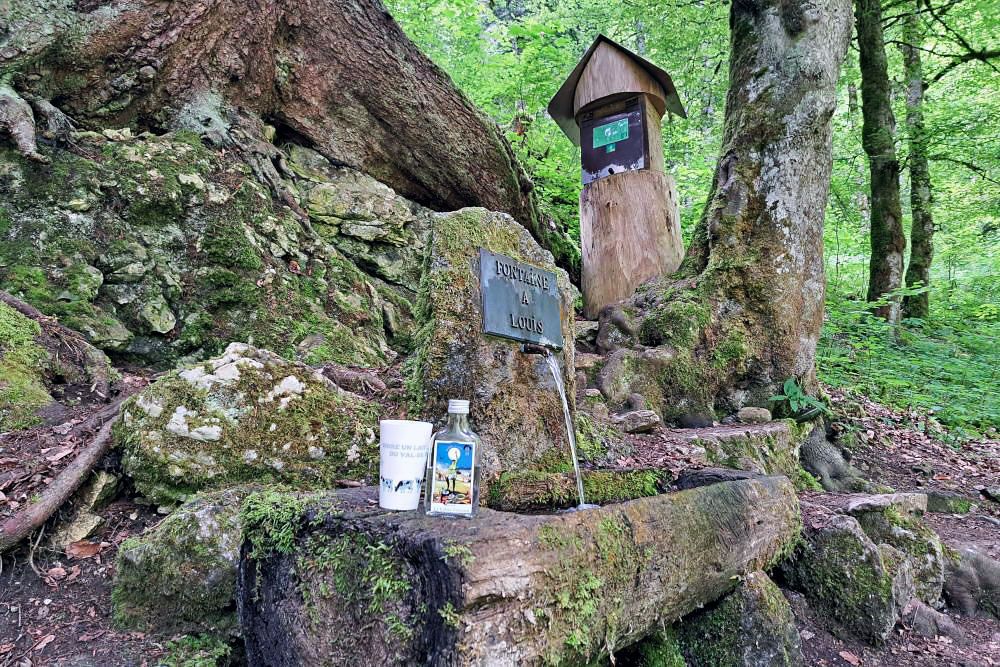
Couvet
When the ban on absinthe was lifted after almost 100 years, it led to great joy in Val de Travers. Producing absinthe was allowed again. Claude-Alain Bugnon in Couvet was one of the first to immediately open his distillery. The charismatic distiller is proud of his profession. The tour is, of course, concluded with a tasting.
Couvet is our endpoint of the Route d’Absinthe. In three days, we’ve learned a lot about absinthe, and certainly also tasted the “green fairy”. We walk around a bit more in the quiet centre. Then we have coffee on a terrace. Afterwards, we return to our starting point by bus. And there we conclude the tours.
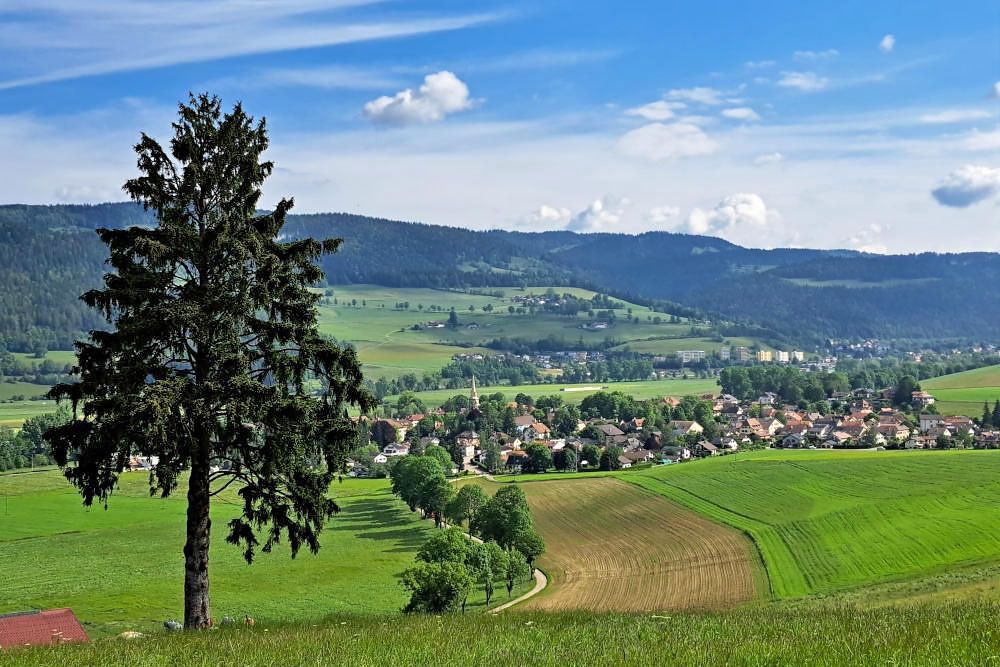
Distillerie Guy
In Pontarlier, we make our last visit to the Distillerie Armand Guy. This is the oldest still active absinthe distillery in the city. It’s a family business that has been producing absinthe according to traditional methods since 1890. During the prohibition period on absinthe, they switched to other products, such as liqueurs and syrups. But the passion for absinthe always remained present. After the lifting of the ban in the 1990s, Distillerie Armand Guy was one of the first to resume the production of absinthe. They now produce different types of absinthe, including the famous Absinthe Guy, which is made according to the original family recipe.
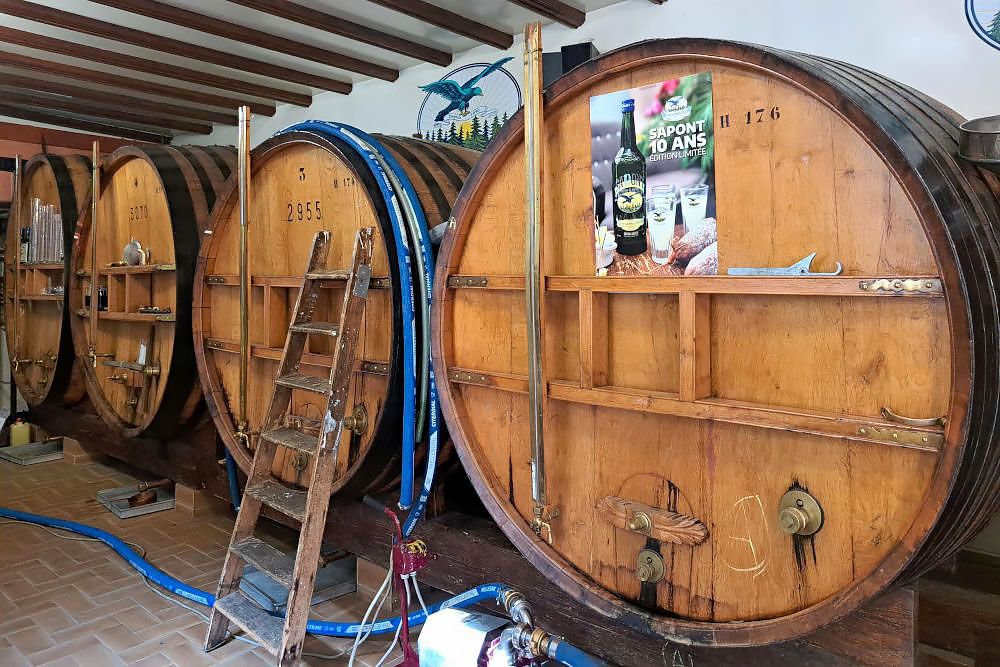
As a conclusion to the tour, we take our last glass of absinthe. A beautiful end to the Route d’Absinthe. A wonderful walking tour with many interesting sights. The beautiful nature of the Jura and Val de Travers in particular was the icing on the cake. During our last dinner of this trip in the cosy Brasserie de la Poste, we think back to the beautiful moments we’ve experienced. After an overnight stay in Hotel Saint-Pierre, we head home with a good feeling.
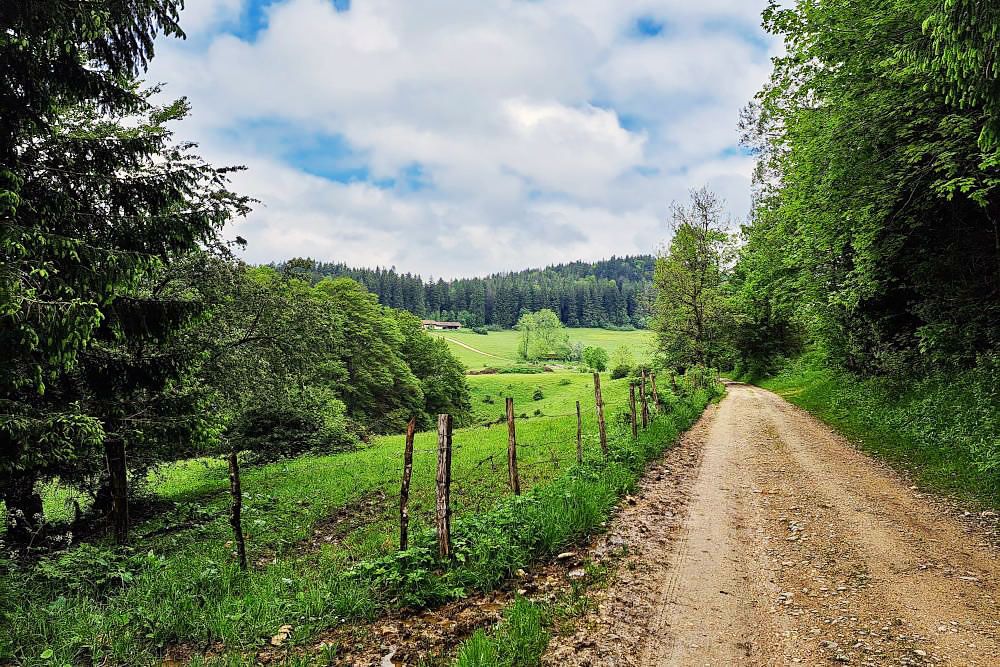
Everything you want to know about the Route d’Absinthe
The Route d'Absinthe is a walking route through the French and Swiss Jura. The route connects Pontarlier in France with Noiraigue in the Swiss Val de Travers. The multi-day walking tour leads along places closely connected to the production and history of absinthe. In addition, the route passes through rolling landscapes with lovely villages in France and Switzerland.
The Route d'Absinthe is about 48 kilometres long. Depending on your pace and the time you spend visiting the sights, you can walk the route in three or four days.
Yes, the walking route is marked in both directions. You can find the symbol of the walking route in the photo below. If needed, you can also download a gpx file.
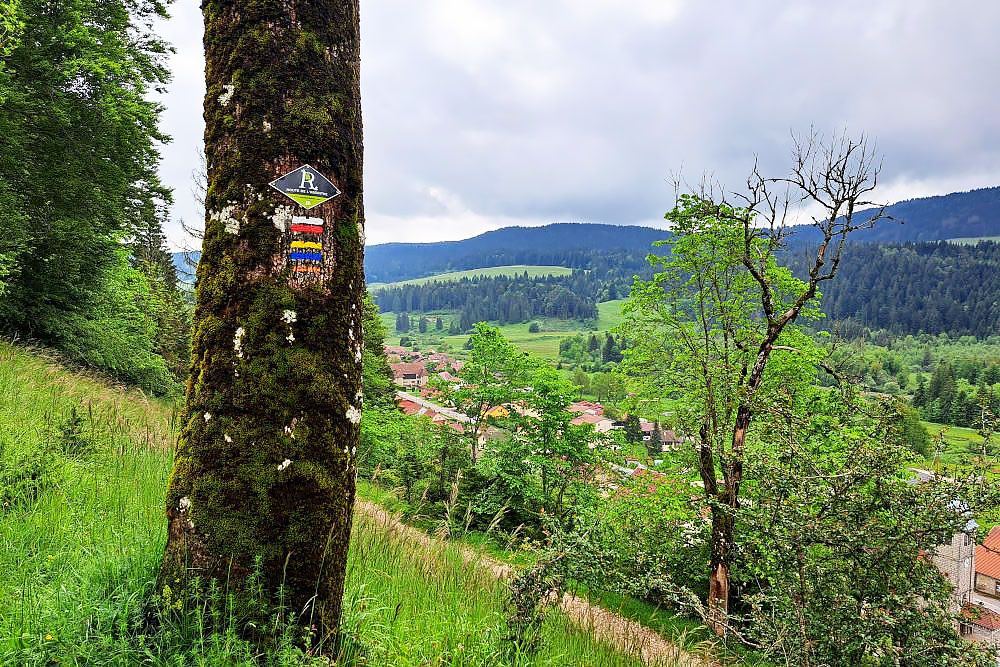
For someone with average walking fitness, the Route d'Absinthe is not difficult. Although the route goes through the hilly Jura, there are few steep climbs. And if there are any, they are very short. The route runs a lot on well-maintained farm roads and forest paths. Part of the route is on paved roads. There is hardly any traffic there, though.
Along the route, you'll encounter numerous historical and cultural highlights, including:
- Distilleries in Pontarlier and the Swiss Val de Travers
- The absinthe museum in Pontarlier
- Château de Joux, an impressive medieval castle
- The picturesque village of Môtiers, an important centre for absinthe production in Switzerland
- The Maison d'Absinthe in Môtiers. This interactive museum is one of the highlights during the walking route.
Pontarlier is located in the French Jura, not far from the city of Besançon. It's easiest to take the car to Pontarlier.
By train or bus, you can comfortably travel back from Noiraigue in Switzerland to Pontarlier in France in about an hour. If you've walked the route in the opposite direction, it's also possible to return by train or bus. Check the Swiss railways app for more information about the exact times.
We stayed in the following accommodations:
- Hotel Saint-Pierre in Pontarlier
- All accommodations in Pontarlier
- Auberge du Château de Joux in La Cluse-et-Mijoux
- Hotel Restaurant Les Cernets near Les Verrieres
- Chambre d'Hôte T22 in Fleurier
- All hotels in Fleurier
- All accommodations in Môtiers
At the invitation of the Bourgogne-Franche-Comté region, Montagnes du Jura and the Bureau du Tourisme Haut-Doubs, we walked the Route d’Absinthe. We have compiled the blog independently and objectively based on our own impressions.
You may also be interested in…
- Absinthe: The green gold of the Belle Époque
- Hiking in the Jura Mountains, the “pure France”
- Nevers, the Burgundian city of the dukes on the Loire river
- Cycling holiday through Burgundy on the Loire
- Burgundy wine route through the Côte d’Or
- Dijon, the Burgundian capital of mustard
- Highlights of the Morvan nature reserve
- Autun, gateway to the Morvan



